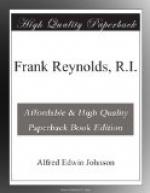[Illustration: “KOSHY”]
[Illustration: NOTE FROM A PARIS SKETCH-BOOK]
[Illustration: FIRST SKETCH FOR “THE SUBURBANITE”]
[Illustration: THE SUBURBANITE. A Sunday Morning Study. From “Social Pests"]
[Illustration: A GOOD STUDY. From “Paris and Some Parisians"]
FRANK REYNOLDS. III.
How does one portray a type? What are the rules that govern the selection of those separate distinctive features which are to form, when blended together, one harmoniously characteristic whole? Frank Reynolds, surely, of all people should be able to answer. But if the question be asked him, he will reply that he does not know. The process is unconscious, or almost so. The portrait “comes” of its own accord. Reflection shows that this must be so. If the artist were to try deliberately to copy this or that feature from concrete personalities, the result would fail to carry conviction. The portrait of a type must be the presentment of an abstract personality—a print, as it were, from a composite negative comprising the likenesses of many individuals, so welded together as to reproduce only that which is common to all: a collective portrait which is like all but resembles none.
[Illustration: There’s no ’olding ’im now, sir, since ’e’s gone into knickers—e’s’ that pomptious! From “Punch"]
It is related of Charles Dickens that the creation of many of his famous characters was inspired by a chance remark overheard in the street. A single telling sentence, uttering some quaint sentiment, perhaps in quaint idiom, would set up a train of ideas ultimately resulting, after much meditative elaboration, in a Mrs. Gamp or a Dick Swiveller. The process is not dissimilar, one imagines, from that by which the artist evolves a character sketch: with this difference, that whereas a solitary trait, accidentally revealed, was to Dickens sufficient foundation upon which to construct his fanciful portrait, such studies of types as Frank Reynolds excels in must be the outcome, not of one “thing seen,” but of reiterated observation of the same thing in identical or closely similar guise. The results in either case vary as the method employed. Mrs. Gamp, the outcome of a single observation, is a type certainly, but exaggerated and “founded on fact” rather than true to life. “The Suburbanite” (see p. 24), though an equally imaginary portrait, is the real thing—the absolute personification of a type or class.
[Illustration]
In the case of Reynolds, his studies of types are the result of an exceptional power of observation coupled with a very retentive memory. His keen eye notes—often unconsciously, as he admits—the small eccentricities by which character is revealed; his sense of humour emphasises them, and his memory retains them. As a result, when he essays to portray a type, there rises before his mental vision, not the figure of this individual or that, but a hazy recollection of all its representatives that he has ever come into contact with. The misty impression materialises as he works, and there grows under his hand a portrait which draws from us an instant smile of recognition, broadening as we perceive the veiled humour and satire that lurk beneath the skilful emphasis which has been laid upon the subject’s salient characteristics.




